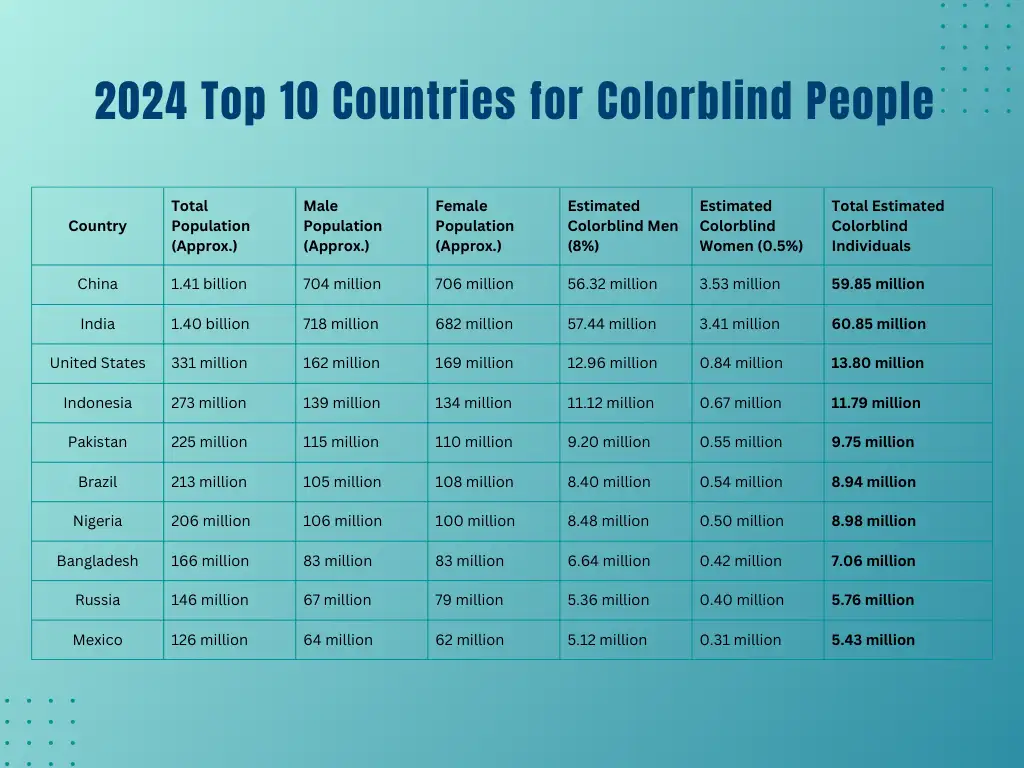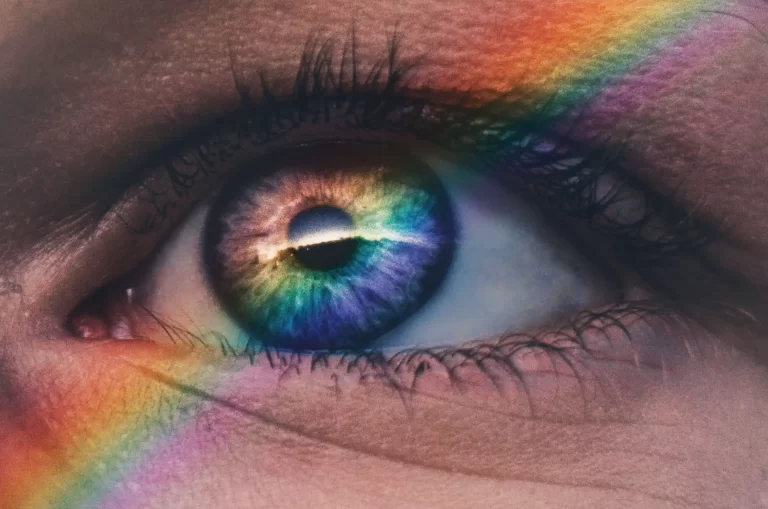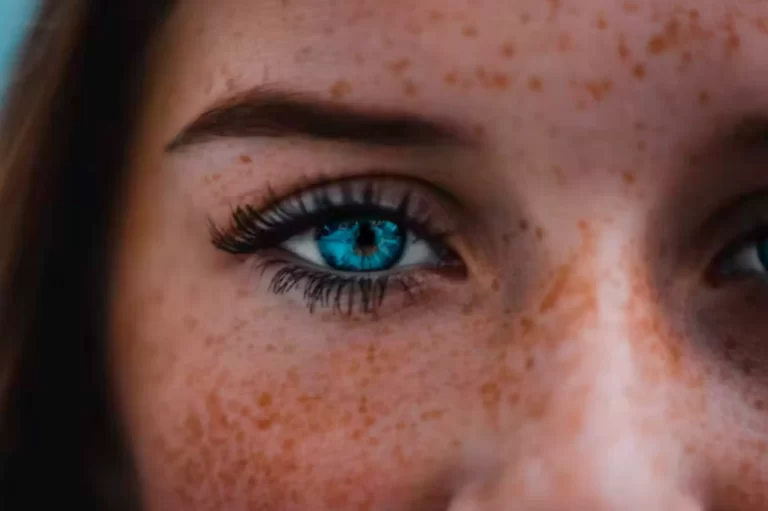Why Am I Colorblind: Understanding the Factors
Color blindness affects how people see and distinguish colors. It’s not a rare condition, impacting millions worldwide. Many don’t even know they have it until they take a test.
Why Am I Colorblind? Color blindness happens when the eye’s color-sensing cells don’t work properly. This can make it hard to tell certain colors apart. For example, some people mix up red and green, while others struggle with blue and yellow.
Most cases of color blindness are passed down from parents to children. It’s more common in men than women. Some people are born with it, while others develop it later due to eye problems or health issues.
Key Takeaways
- Color blindness affects how people perceive and differentiate between colors
- Genetic factors are the most common cause of color vision deficiency
- Early detection and proper tools can help manage the impact of color blindness
Understanding Color Vision
Color vision allows us to see and distinguish different hues. It’s a complex process involving special cells in our eyes and how our brains interpret light signals.
The Role of Cones and Rods
The retina contains two types of photoreceptor cells: cones and rods. Cones help us see color and detail in bright light. There are three types of cones, each sensitive to different wavelengths of light:

- Red cones
- Green cones
- Blue cones
Rods work in dim light but don’t detect color. They help with night vision and peripheral vision.

People with normal color vision have all three types of cones working properly. This allows them to see the full spectrum of colors.
Light and Color Perception
Light enters the eye and stimulates the cones and rods. The cones respond to different wavelengths of light, which we perceive as different colors.

- Red light activates red cones
- Green light triggers green cones
- Blue light stimulates blue cones
The brain combines signals from all three cone types. This creates the rich palette of colors we see.
Some people’s eyes lack one or more cone types. This causes color vision deficiency, also known as color blindness.
How Many People are Colorblind
The global population in 2024 is approximately 8.2 billion.The number of males in the world is approximately 4.1 billion.the number of females in the world is approximately 4.01 billion.
Based on the data from Wikipedia and Worldpopulationreview Number of Colorblind Men about 328 Millions,Number of Colorblind Women about 20 Millions in 2024.
Top 10 Countries for Peoples are colorblind

How Many Men are Color Blind
Approximately 8% of men are color blind. Given that the global male population is estimated to be around 4.1 billion, this translates to roughly 328 million men worldwide who have some form of color vision deficiency.
Top 10 Countries for Men are colorblind
| Country | Male Population (Approx.) | Estimated Colorblind Men (8%) |
|---|---|---|
| China | 704 million | 56.32 million |
| India | 718 million | 57.44 million |
| United States | 162 million | 12.96 million |
| Indonesia | 139 million | 11.12 million |
| Pakistan | 115 million | 9.20 million |
| Brazil | 105 million | 8.40 million |
| Nigeria | 106 million | 8.48 million |
| Bangladesh | 83 million | 6.64 million |
| Russia | 67 million | 5.36 million |
| Mexico | 64 million | 5.12 million |
World population data based on Statisticstimes and Wikipedia
Why Do Women Have Better Color Vision
Women generally have better color vision than men for a few reasons:
- Genetics: The genes for the most common types of color blindness are on the X chromosome. Women have two X chromosomes, so a defective gene on one X can be compensated by a normal gene on the other.
- Tetrachromacy: Some women may have four types of cones instead of three. This rare condition allows them to see more colors than the average person.
- Evolutionary factors: Better color vision may have helped women gather food and care for children in our evolutionary past.

These factors combine to give women an advantage in color perception over men.
Genetic Factors of Color Blindness
Why Am I Colorblind? Color blindness is mainly caused by genetic factors. These factors are closely tied to the X chromosome and affect males and females differently.
X Chromosome and Color Vision
The genes for red-green color vision are found on the X chromosome. This explains why color blindness is more common in males. Men have only one X chromosome, so if it carries the color blindness gene, they will be color blind.
Women have two X chromosomes. They need the color blindness gene on both to have the condition. This makes it less likely for females to be color blind.
For a male to inherit color blindness, his mother must carry the gene. A female can be a carrier without having color blindness herself. She has a 50% chance of passing the gene to her children.
In rare cases, a woman can be color blind if she gets the gene from both parents. This happens much less often than in males.
Is Color Blindness a Disability?
Color blindness can be considered a disability in certain situations. The Americans with Disabilities Act (ADA) does not have a specific list of conditions that qualify as disabilities.
For color blindness to be deemed a disability, it must substantially limit a major life activity. This assessment is done on a case-by-case basis.
In the workplace, color blindness may be recognized as a visual disability if it affects job performance. Employers might need to provide reasonable accommodations for affected employees.
Types of Color Vision Deficiency
Color vision deficiency affects how people see colors. It comes in different forms, ranging from mild to severe. The main types are red-green, blue-yellow, and complete color blindness.
Red-Green Color Blindness
Red-green color blindness is the most common type. It makes it hard to tell red and green apart. There are four subtypes:
- Deuteranomaly: Green looks more red
- Protanomaly: Red looks more green
- Deuteranopia: Can’t see green at all
- Protanopia: Can’t see red at all
Deuteranomaly is the most common form. It affects about 5% of men. People with this type may have trouble with traffic lights or picking ripe fruit.
Blue-Yellow Color Blindness
Blue-yellow color blindness is rare. It makes it hard to tell blue from green and yellow from red. There are two types:
- Tritanomaly: Reduced blue sensitivity
- Tritanopia: No blue cones at all
This type affects both men and women equally. People with blue-yellow color blindness might mix up blue and green clothes or have trouble seeing yellow highlighter on white paper.
Complete Color Blindness
Complete color blindness is very rare. People with this type see only in shades of gray. There are two forms:
- Achromatopsia: No working cone cells
- Cone monochromacy: Only one type of cone works
Those with complete color blindness may also have poor vision and be sensitive to light. They might need special lenses or glasses to help them see better in bright light.
Diagnosis and Detection
Finding out if you have color blindness involves specific tests and professional evaluation. These methods can reveal if you see colors differently than most people.
Professional Evaluation by Eye Doctors
Eye doctors use special tests to check for color blindness. The most common test is the Ishihara color test. It uses plates with colored dots that form numbers or shapes. People with normal color vision can see these easily.
Those with color blindness might have trouble seeing the patterns. Eye doctors may also use other tests like:
- Arrangement tests
- Matching tests
- Computerized color vision tests
These tests help determine the type and severity of color blindness. Some people don’t know they have color blindness until they take these tests.
Early detection is important, especially for children. It can help them get the right support in school. Adults might need to know for certain jobs that require good color vision.
Eye doctors can also rule out other eye problems that might affect color vision. They can provide advice on how to manage color blindness in daily life.
Impact of Color Blindness
Color blindness affects many aspects of a person’s life. It can create challenges in daily activities and social interactions.
Daily Life and Adaptations
People with color blindness often face hurdles in everyday tasks. Picking out clothes can be tricky, as matching colors becomes difficult.
Traffic lights may look different, making driving more challenging. To adapt, some learn the position of lights instead of relying on color.
Reading maps or charts with color-coded information can be hard. Many use special tools or apps to help identify colors.
In the workplace, color-coded systems may pose problems. Some jobs, like electrician work, might be off-limits due to safety concerns.
Psychological and Social Aspects
Color blindness can affect a person’s confidence and social life. Kids might struggle in school with colored learning materials.
Some people feel embarrassed about their condition. They may worry about making mistakes or being judged by others.
Red-green colorblindness, the most common type, can make it hard to enjoy certain activities. Watching sports teams in similarly colored uniforms can be confusing.
Despite challenges, many with color blindness lead full lives. They often develop unique ways of seeing the world and solving problems.
Associated Conditions and Complications
Color blindness can be linked to various eye and systemic health issues. These conditions can affect how a person sees colors and may lead to additional vision problems.
Eye Diseases and Color Vision
Glaucoma can cause color vision problems. This eye disease damages the optic nerve, which can change how colors look. People with glaucoma might have trouble telling blue and yellow apart.
Cataracts can also affect color vision. As the eye’s lens gets cloudy, colors may seem faded or less bright. This can make it hard to see the difference between some colors.
Age-related macular degeneration (AMD) is another eye condition that can impact color vision. AMD affects the part of the eye that sees fine details and colors. This can make colors look less vivid or harder to tell apart.
Systemic Diseases Affecting Vision
Some health problems that affect the whole body can also change how we see colors. Diabetes is one such disease. It can damage blood vessels in the eye, leading to vision changes including color perception problems.
Multiple sclerosis (MS) can affect color vision too. MS damages nerves in the brain and spinal cord. This can change how the brain processes visual information, including colors.
Sickle cell anemia and leukemia are blood disorders that can impact color vision. These conditions can affect blood flow to the eyes, which may lead to vision changes.
Some people with color vision problems may also have nystagmus. This causes rapid eye movements and can make it harder to see clearly.
Advancements and Tools for Managing Color Blindness
New tools and technologies have emerged to help people with color blindness. These advancements aim to improve color perception and make daily tasks easier.
Corrective Lenses and Filters
Color correction glasses have made significant strides in recent years. These special lenses use filters to enhance color differences, making them more noticeable to colorblind individuals.
Some popular brands include Covisn,Colorkinds and Enchroma . These glasses work by selectively filtering out certain wavelengths of light. This helps the brain better distinguish between colors.
Not all glasses work for everyone. Their effectiveness depends on the type and severity of color blindness. Some people report dramatic improvements, while others see more subtle changes.
Contact lenses with similar color-enhancing technology are also available. These can be a good option for those who prefer not to wear glasses.
Technology and Software Aids
Digital tools have opened up new possibilities for managing color blindness. Many devices and apps now offer colorblind modes to adjust screen colors.
Smartphone apps can identify colors in real-time using the device’s camera. This helps colorblind individuals in situations like choosing clothes or reading color-coded information.
Computer software and browser extensions can modify website colors to make them more distinguishable. This improves accessibility for colorblind users when browsing the web or using digital tools.
Color simulators allow people with normal vision to see how colorblind individuals perceive colors. This can be helpful for designers creating colorblind-friendly content.
How to Correct Color Blindness
Color blindness cannot be fully corrected, but there are ways to manage it. People with this condition can use special tools and techniques to help them see colors better.
Color-correcting glasses are one option. These glasses use filters to change how colors look. They can make some colors easier to see, but they don’t fix color blindness completely.
Another tool is the Seekey device. It has red and green filters that help people tell these colors apart. This is useful for those with red-green color blindness, which is the most common type.
Some apps and computer programs can also help. They change colors on screens to make them easier to see. This can be helpful for work or school tasks.
Special contact lenses are another option. Like the glasses, they use filters to change how colors look. But they might not work for everyone.
It’s important to note that these tools don’t cure color blindness. They just help people manage it better. Eye doctors can give advice on which options might work best for each person.
Research is ongoing to find new ways to help. Scientists are looking into gene therapy and other new treatments. These might offer more help in the future.
How to Pass a Color Blind Test
Passing a color blind test can be challenging for those with color vision deficiencies. There are no guaranteed ways to overcome color blindness during testing.
Color blind tests check if you can accurately see colors. They typically involve identifying numbers or patterns within colored dots or shapes.
Some people try to memorize common test plates. This approach is unreliable, as tests often use multiple versions to prevent cheating.
Color-correcting contact lenses exist, but their use is usually prohibited during official color vision screenings.
It’s important to note that attempting to deceive color vision tests can be dangerous, especially for jobs requiring accurate color perception.
The best approach is to be honest about your color vision abilities. Many careers and activities are still accessible to those with color blindness.
If you suspect color blindness, take an online color vision screening for initial insight. Follow up with an eye care professional for a comprehensive assessment.
Remember, color blindness is a common condition affecting many people. Embracing your unique visual perception is often the healthiest approach.
Frequently Asked Questions
Color blindness affects many people and raises questions about its causes, diagnosis, and impact. These FAQs cover key aspects of color vision deficiency, from genetic factors to potential treatments.
What causes color blindness genetically?
Color blindness is often inherited through genes. The most common form is X-linked, passed down through the mother’s genes. This explains why more men are affected than women.
Mutations in genes responsible for cone cells in the retina lead to color vision problems. These genes code for light-sensitive pigments that allow us to perceive different colors.
How is color blindness diagnosed?
Eye doctors diagnose color blindness using special tests. The Ishihara Color Test is a common method. It uses plates with colored dots forming numbers or shapes.
Patients look at these plates and identify what they see. Those with color vision deficiency may struggle to see certain numbers or patterns.
Which vitamin deficiency causes color blindness?
Vitamin A deficiency can lead to color vision problems. This vitamin is crucial for the proper functioning of retinal cells.
Severe lack of vitamin A may cause night blindness and eventually impact color perception. However, this type of color blindness is rare in developed countries.
What race has the most color blindness?
Color blindness rates vary among different populations. Caucasians have higher rates compared to other races.
Studies show lower prevalence in African and Asian populations. However, genetic factors play a bigger role than race in determining color blindness.
Are there any treatments available for color blindness?
Currently, there’s no cure for inherited color blindness. Some specialized glasses or contact lenses may help enhance color perception for some people.
Gene therapy shows promise in research but isn’t widely available yet. For now, most treatments focus on helping people adapt to their condition.
How to test if you’re color blind?
Online color blindness tests offer a quick initial assessment. These typically use Ishihara-style plates or other color-based challenges.
For an official diagnosis, visit an eye care professional. They can perform comprehensive tests and determine the type and severity of color vision deficiency.
What are the advantages of being color blind?
Some studies suggest color blind individuals may have enhanced night vision. They might also be better at detecting camouflage.
In certain situations, color blind people may notice patterns or details that others miss. This can be useful in fields like military operations or wildlife spotting.
What does night blindness mean?
Night blindness is difficulty seeing in low light conditions. It’s different from color blindness but can sometimes occur alongside it.
People with night blindness struggle to adjust their vision when moving from bright to dim environments. This can make nighttime activities challenging.
Can you be colorblind but still see colors?
Yes,most color blind people can see colors, just differently. Complete color blindness where everything appears in shades of gray is extremely rare.
Most forms of color blindness involve difficulty distinguishing between certain colors, typically reds and greens.
Are you born color blind or can you develop it?
Most color blindness is present from birth due to genetic factors. However, some people can develop color vision problems later in life.
Acquired color blindness may result from eye injuries, certain diseases, or medication side effects. Age-related changes can also affect color perception over time.








